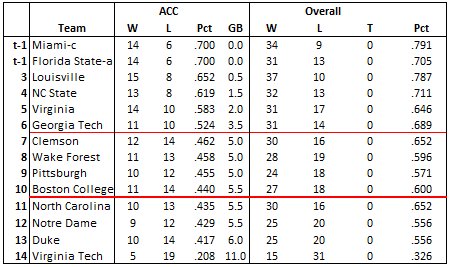ACC Baseball Tiebreakers
(as of 4/24/16)
QUALIFICATION
The top team from both the Atlantic and Coastal divisions, determined by conference winning percentage, and the next eight teams with the best conference winning percentage regardless of division will be selected to participate in the Conference Baseball Championship. The two division champions will automatically be seeded number one and two based on winning percentage in overall conference competition, and the number one seed shall have the choice of its preferred day off. The remaining teams will be seeded (three through ten) based on winning percentage in overall Conference competition without regard to division. All ties will be broken using the tie-breaking provisions.
SEEDING
In the case of a tie in conference winning percentage, championship seeding will use the tie-breaking procedures below with the following guidelines:
• When comparing tied teams and arriving at another pair of tied teams, use each team’s winning percentage against the tied teams as a group. For example, if Teams A and B have the same winning percentage as compared to Team C; then Teams A and B will be compared to Team D, but if Team D is tied with Team E, then Teams A and B will be compared to the winning percentage of Teams D and E collectively, not individually.
• When comparing records against a single team or group of teams, the higher winning percentage shall prevail even if the number of games played against a team or group of teams is unequal. If winning percentage of the tied teams is equal against a team, or a group of tied teams, continue until one team gains an advantage.
• If multiple teams tie and the tie can be reduced to two teams, the provisions for two team ties will be used from that point forward.
• One completed game of a conference series constitutes a common opponent for tie breaking purposes.
1. Division Champion Determination.
(a) The division champion will be the team in each division with the highest overall conference winning percentage.
(b) Head-to-head conference competition between the tied teams.
(c) Records of the tied teams within their division.
(d) Head-to-head competition of the tied teams versus the team within the division with the best overall conference winning percentage (divisional and non-divisional) and proceeding through the division.
(e) Head-to-head competition of the tied teams versus common opponents in the opposite division with the best overall conference winning percentage (divisional and non-divisional) and proceeding through the opposite division.
(f) Coin flip.
2. Seeds One and Two Determination.
(a) Head-to-head competition in regular-season conference play between the two tied teams.
(b) Head-to-head competition of the tied teams compared to common opponents (divisional and non-divisional) with the highest conference winning percentage and continuing until one team gains an advantage.
(c) Coin flip.
3. Seeds Three Through Ten Determinations.
(a) Divisional Opponents.
Two-Team Tie
(1) Head-to-head competition between the two tied teams.
(2) Records of the tied teams within the division.
(3) Head to head competition of the tied teams versus the team within the division with the best overall conference winning percentage (divisional and non-divisional) and proceeding through the division. Multiple ties within the division broken from first to last.
(4) Overall record versus all common non-divisional opponents.
(5) Combined record versus all non-divisional opponents.
(6) Record versus common non-divisional opponents based on their order of finish within their division.
(7) Coin flip.
Three-or-More-Team Tie
(1) Combined head-to-head record among the tied teams.
(2) Records of the tied teams within the division.
(3) Head-to-head competition versus the team within the division with the best overall (divisional and non-divisional) conference winning percentage, and proceeding through the division. Multiple ties within the division will be broken first to last.
(4) Overall record versus non-divisional opponents.
(5) Combined record versus all common non-divisional opponents.
(6) Record versus common non-divisional opponents with the best overall conference (divisional and non-divisional) winning percentage and proceeding through the other common non-divisional opponents based on their order of finish within the division.
(7) The seed(s) shall be chosen by a draw.
(b) Non-Divisional Opponents.
Two-Team Tie
(1) Head-to-head conference competition between the tied teams.
(2) Head-to-head competition of the tied teams compared to common opponents with the highest overall conference winning percentage and continuing until one team gains an advantage.
(3) Coin flip.
Three-or-More-Team Tie
(1) Combined head-to-head record among the tied teams (if common opponents).
(2) Head-to-head competition of the tied teams compared to common opponents with the highest overall conference winning percentage and continuing until one team gains an advantage.
(3) The seed shall be chosen by a draw.



